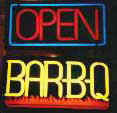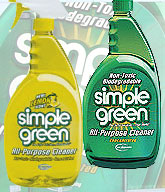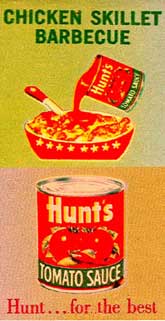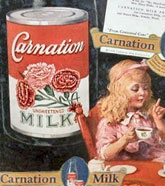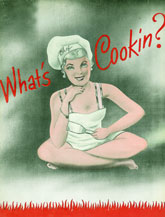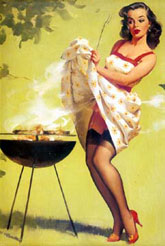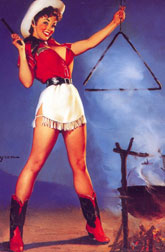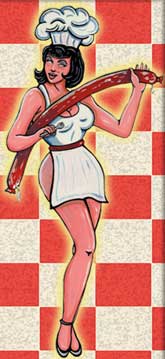Contact BBQbyDan
www.BBQDan.com
Search
KCBS BBQ Cook-Off Info
Recipes,
Smoking Meats
Recipes, Grilling
|
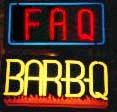 |
FAQ OF THE INTERNET BBQ LIST Version 2.0 Section 16 Barbecue Portion size |
--------------------
[How much should I cook of the following items to feed 25 men for supper--brisket, baked beans and coleslaw?]
David S. Gerard--(David is a professional chef.)
Industry standards are for 4-5 ounces cooked weight for meat and 6 ounces for sides. Assume a 35-40% shrinkage for the brisket. The fact that it is all men means you probably won't be serving gala appetizer trays. I would suggest two 10 pound briskets. This allows a good safety measure and maybe a little doggie bag. Extra beans can be prepared as they freeze extremely well--if made from dry beans, not doctoring up the canned variety. Dried beans swell to three-fold weight so I'd start with 5 pounds dry beans. Shred 9-10 pounds raw cabbage for your slaw. These figures are generous, but you don't want 25 hungry men looking at you across the table. Some nice buttermilk country biscuits or sweet cornbread (with whole corn in it) would be nice.
Editor--now, if you're planning on entertaining 25 guys from the BBQ List for dinner, triple all amounts.
-------------------[I got a job catering a tire show. Probably around 75 mechanic/tire guys. They want pork, beef and chicken. Can anybody give me an idea of how much of each I'll need, I was thinking pork butts, brisket and leg quarters?]
Danny Gaulden--
If you want to provide about 1/2 lb. per person with the butts and brisket, and divide the meats equally into three parts( 1/3 pork, 1/3 brisket, 1/3 chicken), here's what you will need to barbecue. You will need to cook about 32 lbs. of pork, 32 lbs. of brisket, and 50 leg quarters. Brisket and butts cooked, trimmed, and served properly will yield about 40%. This will give each person a choice of either 2 leg quarters each, or 1/2 lb. of pork or brisket, or, of course, a mixture. This is plenty to fix and stay within a reasonable fee. If they eat it all, one thing is for sure--they won't go home hungry and have bad things to say about you.
One thing you must remember when doing a cater--you don't want to fix too much and have to charge a price that seems unreasonable. Nor do you want to prepare too little. A fine line is drawn here. When giving a bid on a cater, always make sure the customer knows how many pounds of meat your are providing, and how many pints, quarts, or gallons of sides are included also. This allows the customer to "really" know what they are getting for the money. Also this lets them see that the "cheaper" bid isn't necessarily the best bid.
When talking to a potential customer about a barbecue catering job, the first question I ask them is to define the average age, sex, and how many small children are going to attend the event. This helps me "size up" the meal, and determine how much they will need. I basically have three sizes--small portions (usually senior citizens or women only), medium portions (this is for the majority of folks that are all ages, sex, and some children) and large portions (the kind of group you are feeding--mostly men, and hard working folks.)
If you are preparing sides, figure about 3 people to the pint for average eaters, and 2 to 2 1/4 for heavy hitters.
Here's how I figure sides: If you put lots of stuff into you potato salad, as I do, 10 lbs. of potatoes will yield about 12 pints of finished product. Use lots of eggs--this separates you from the "cheapies". About one egg per pound of potatoes works good--not too strong, but you definitely know they are there. Example: for ten pounds of raw potatoes, cook 10 eggs. Dried beans will slightly more than double in size when soaked over night and cooked. Example: 10 pints of dried beans will make at least 20 pints after they're cooked. Probably closer to about 22-23 pints. Cole slaw: figure about 7 pints out of one gallon of shredded cabbage, carrots, etc. Remember, slaw will pack down a bit when the dressing is added. That's why you will end up with less than you started with when making slaw.
Here is what I served at a recent cater to some US Government folks: brisket, turkey, ribs, pulled pork, potato salad, coleslaw, pinto beans, homemade yeast rolls, relish tray with pickles, onion slices, and cherry peppers, plus cherry and apple cobbler for dessert.
-------------------[I want to take a home-style recipe and scale it up to feed about 50 people. I've heard that you should not scale up spices directly. Any help with this problem?]
Kit Anderson--
This comes from the McCormick Web site. ![]() Click here to visit site
Click here to visit site
It doesn't say why, but I suspect it has to do with pH, heat, and other factors affecting extraction of the essential oils.
Scaling:
Foodservice kitchens often need to scale up small-sized recipes to large quantity proportions. Most ingredients can be increased in direct relation to the total recipe increase. However, spices need special attention as the flavor of certain spices intensifies as the build-up increases. Experimentation and testing are the keys to success in increasing spices in the proper proportions but there are some tips which can serve as a starting point.
The tropical spices (black pepper, cinnamon, ginger, allspice, cloves; but not nutmeg and mace) can usually be increased proportionately - double the recipe, double the spice. This must be done accurately, however, measuring by weight and not by volume. This applies to such blends as curry and chili powders and apple and pumpkin pie spices, but not Italian seasoning.
Nutmeg, mace, and Italian seasoning use the following herb formula:
For the first 100% increase in portions, herbs can also be doubled. After that, for each multiple of the original recipe, add only half the original amount of herbs. For example, a recipe for 10 using 1 tablespoon basil (3.3 gr.) scaled up to 100 portions: 20 portions = 2 tablespoons basil (6.6 g.); the remaining 80 portions = 8 x 1/2 tablespoon (1.65 g.) = 4 tablespoons basil (13.2 g.); 100 portions total = 2 + 4, or 6 tablespoons basil (19.8 g.).
Italian Seasoning is a blend of marjoram, thyme, rosemary, savory, sage, oregano and basil. (I bet tarragon, dill, and other leafy herbs fit in this category as well.)
Hot red pepper builds up even more quickly than the herbs. For the first doubling of the recipe, the red pepper can still be doubled. After that, however, use only 1/4 the original amount of pepper for each multiple of the original recipe. To increase from 10 to 100 portions when 1/4 teaspoon red pepper (.525 g.) was used for 10 portions: 20 portions = 1/2 teaspoon red pepper (1.05 g.); the remaining 80 portions = 8 x 1/16 teaspoon, or 1/2 teaspoon (1.05 g.); 100 portions total = 1 teaspoon red pepper (2.1 g.).
Go to the next section
Return to the Table of Contents
Return to the BBQ FAQ Home Page
Comments or Suggestions
BBQ FAQ Ver 1.0, 2.0 ©1997, 1998 William W. Wight. All rights reserved.

